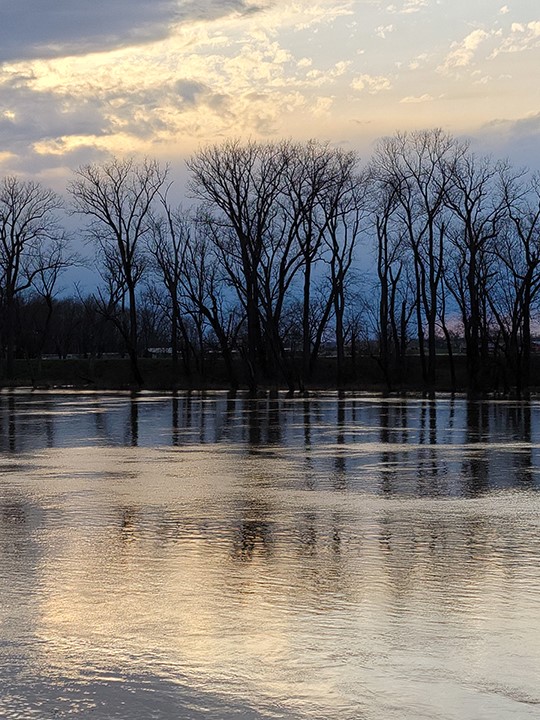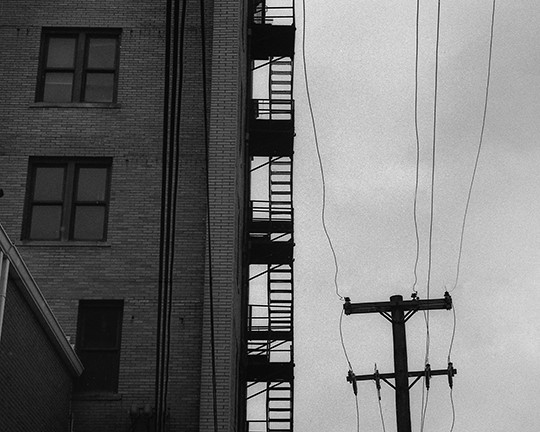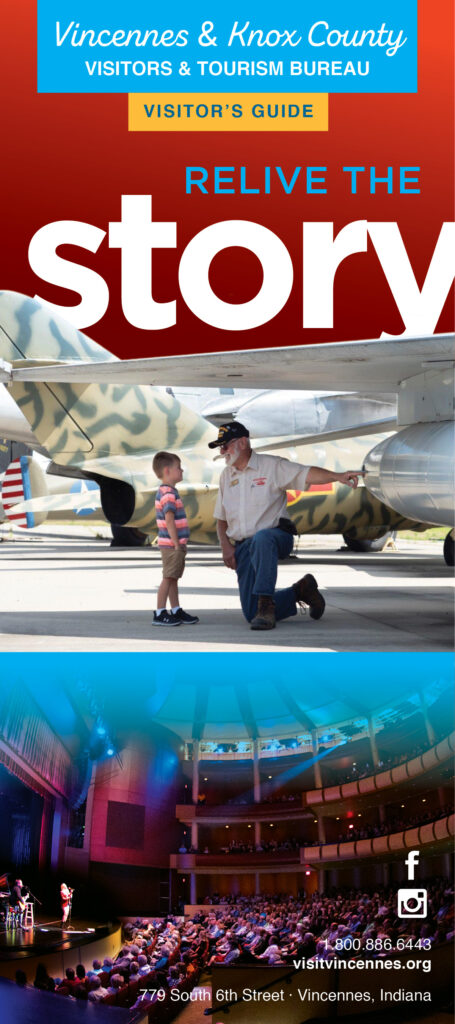
Art Space exhibits Bartholomew, Messer
May 5, 2023 @ 5:00 am – June 17, 2023 @ 5:00 pm

The work of Carol Messer and Tom Bartholomew will be at ArtSpace beginning First Friday this week.
From the still capture of a rural moment, to a thrumming hum of more urban life, photographers Carol Messer and Tom Bartholomew will show divergent but harmonious views of “where we are” in an exhibit by the same name that opens Friday, as part of the first Friday Art Walk series, then continuing through June 17. The exhibit will host receptions from 5-8 p.m. May 5 and June 2, then will continue Tuesdays through Sundays from noon to 5 p.m. at Art Space Vincennes, at 521 Main Street.
A word from ArtSpace:
We felt it would be interesting to see the points of connection and divergence that would provoke thought if these two photographers dealing with essentially the same subject matter but with different points of view, were represented together in an exhibition. The two images used for the exhibition postcard, can get us started.
Tom had closed his wedding photography business and was on a mission to explore his own creative work. We saw images on his Facebook page described as “adventures in black and white”. He was driving around Knox County photographing the landscape and buildings, the latter often deserted and falling into disrepair with the passage of time. We were struck by the evocative silence and compelling mystery that seemed to envelope these new subjects.
Carol had embarked on her project of photographing rural farms and fields, often in the magic light of evening, as a path through the isolation of the Covid pandemic. She brought some of her photographs into the gallery one afternoon, and we ended up spending hours with her, newly impressed by every image we saw.
We became aware last year that both Carol Messer and Tom Bartholomew were engaged in photographing Knox County surroundings.
Water surrounds trees whose trunks merge into their reflections. Compositionally we see three horizontal layers. At the top, moving clouds create a band of grays and warm whites. Leafless tree branches reach up to touch the clouds. The middle ground falls from blue into darkness, with a surprising glimpse of coral at the horizon. We can barely discern a road, and buildings that line it, behind the trees. The shimmering river takes up almost the entire bottom half of the format, varying between the greenish blue of reflected sky and the grayer surface of the water, with its light lines and shapes of reflected clouds. The light is fading quickly. Although stillness prevails, all is changing moment by imperceptible moment.
Her work calls to mind the Hudson River School painters whose landscape paintings were intended to evoke the presence of the “sublime” in nature.
In her artist statement Carol writes: “These photographs stop time and capture the “now,” treasuring up for us moments of grace as we contemplate the enormous panorama of earth meeting sky…[they] celebrate the play of light on the earth, the dance of color in our fields and on trees, the dampness of rain in our ditches, the fecundity of our fields and daily, the incredible play of clouds in the skies above us.”
The appearance of farm buildings in Carol’s paintings is significant – they reference the people who work the land, and their small footprint reminds us of the vastness of the natural forms and forces within which we live. One thinks of the landscapes of the Chinese poet-painters, in which the human-made temples and bridges are barely discernible.
Carol’s recent full embrace of photography has evolved from a lifetime of engagement with the fine arts in many forms. She studied painting and drawing, and focused on printmaking in both undergraduate and graduate work. While earning her MFA at the University of Kentucky, she became interested in landscape art and classical European gardens, and began to experiment with landscape sculpture in porcelain. Her many art-related life experiences have included teaching, mounting exhibitions, and serving as Director for the Bergen County Division of Cultural and Historic Affairs in Bergen County, New Jersey. Her passionate interest in medieval architecture has taken her to the UK and France to visit cathedrals. It was in this travel that she “discovered the art of photography as a means of furthering her involvement in the arts”.
Moving from nature to the constructs of man, this photograph by Tom Bartholomew could be considered a portrait of a building. Like Carol’s photograph, it is also divided into thirds, this time vertically. A dark, imposing structure dominates the format left. Diagonals within and around it create a disquieting sense of potential shift and upheaval. Gray sky provides a backdrop for fire escape ladders in the center and telephone pole with its undulating wires on the right. There are no people, but humans were the builders and their creations have anthropomorphic character, the building on the left heavy and morose, the ladders, telephone pole and wires ephemeral and tentative.
Tom notes, “As a newspaper photographer and as a wedding and portrait photographer my work dealt undeniably with people; the things they did and the way they did them.” What distinguished Tom’s photography, as he served the public in these two differing ways, was attention to how he presented his subject(s). He gave thought to context and composition, offering unexpected paths to the delicate balance of unity and variety and introducing the element of surprise.

In Tom’s retirement journey the human presence in his photographs continues to be essential.
“Driving around in rural America, the landscapes I stop to photograph more often than not bear the marks of people. A pump house, a church or the boarded-up windows of a Main Street nobody visits anymore all tell the story of the people who were there. In rural America it’s frequently the story of people and an economy that have moved on. Of all the images I delivered for this show only one had an actual person in it. But they all have people in them.”
Tom’s work continues to be narrative, telling a story. This makes sense given his grounding in photo-journalism. At Columbia College he worked with John H. White, a nationally celebrated photographer who received a Pulitzer Prize in Photojournalism. Other artists he cites as influential, such as Susan Meiselas, Danny Lyon and Dennis Stock are affiliated with the Magnum Foundation and Magnum Photos. The Foundation is dedicated to expanding creativity and diversity in documentary photography and supports “a global network of social justice and human rights-focused photographers and experiments with new models for storytelling”.
Tom’s interest in social justice, and his compassion for those whose lives are defined by struggle has manifested both in what he has studied and where he has worked. His studies have included coursework in sociological theory, urban sociology, statistics, Marxian sociology, personality theory, organizational behavior, social inequality, the American elite, behavioral methods, cultural anthropology and social psychology. He has worked and volunteered in many care settings, including staff and administrative positions in nursing homes, and activities development for the local YMCA Senior Services Project.
The photographs Tom is showing in this exhibition ask the viewer to consider how these abandoned buildings, empty rooms and other-worldly landscapes came to be as they are. He does so with compositions that foster a sense of mystery and questioning unease.
Thinking about the points of connection one can find between these two artists, I find myself considering what the medium of photography can uniquely offer, and what these two artists are offering through it.
Although technology now offers such a spectrum of ways photography can be manipulated, in the end it still carries a historical sense of being grounded in fact, authenticity, and truth. “The camera never lies.” I feel that both artists have arrived, after lifetimes of work, and thinking, and searching, and more work, at discovering increasingly refined “truths” to share with us. But these truths are more like questions or gentle suggestions than bodies of knowledge. Both ask us to stop, and look at and consider places and ideas we might ordinarily pass by, distracted by the increasing complexity of just getting through the day. They gift us with the experiences latent for us in what they have learned to see.
Tom’s photographs invite us to connect with the ghosts or spirits or unseen presences of people no longer with us which seem somehow to adhere to or be inherent in the spaces and objects they created and the atmospheric landscapes through which they have passed.
Carol’s photographs, in her words, share her “many sacred and fleeting moments in our farms, fields and woods” with hope that we too can find the “song within our deepest self that is good and finds itself wonderfully expressed in our connection with nature.”
Both are asking us to tune into the unseen that is not beneath or beyond what is seen, but is exquisitely embodied within it, present now, outside of time.
–An Art Space Gallery preview of the “Where We Are” exhibit by Andy Jendrzejewski


